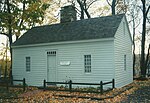Dooney & Bourke
1975 establishments in Connecticut2000s fashionBags (fashion)Clothing companies of the United StatesCompanies based in Fairfield County, Connecticut ... and 5 more
Companies based in Norwalk, ConnecticutCorporate scandalsDesign companies established in 1975Fashion accessory companiesUse mdy dates from August 2022

Dooney & Bourke is an American luxury leather goods brand founded in 1975 by designer Peter Dooney and entrepreneur Frederic Bourke in Norwalk, Connecticut. Originally a men's supplier of belts, suspenders, and ties, the company now specializes in handbags and small accessories. Peter Dooney has maintained his role as designer at the company throughout the brand's history. Dooney's competitors include Coach and Kate Spade.
Excerpt from the Wikipedia article Dooney & Bourke (License: CC BY-SA 3.0, Authors, Images).Dooney & Bourke
Regent Street, Norwalk
Geographical coordinates (GPS) Address Nearby Places Show on map
Geographical coordinates (GPS)
| Latitude | Longitude |
|---|---|
| N 41.106248 ° | E -73.3993482 ° |
Address
Dooney & Bourke
Regent Street 1
06855 Norwalk
United States
Open on Google Maps








